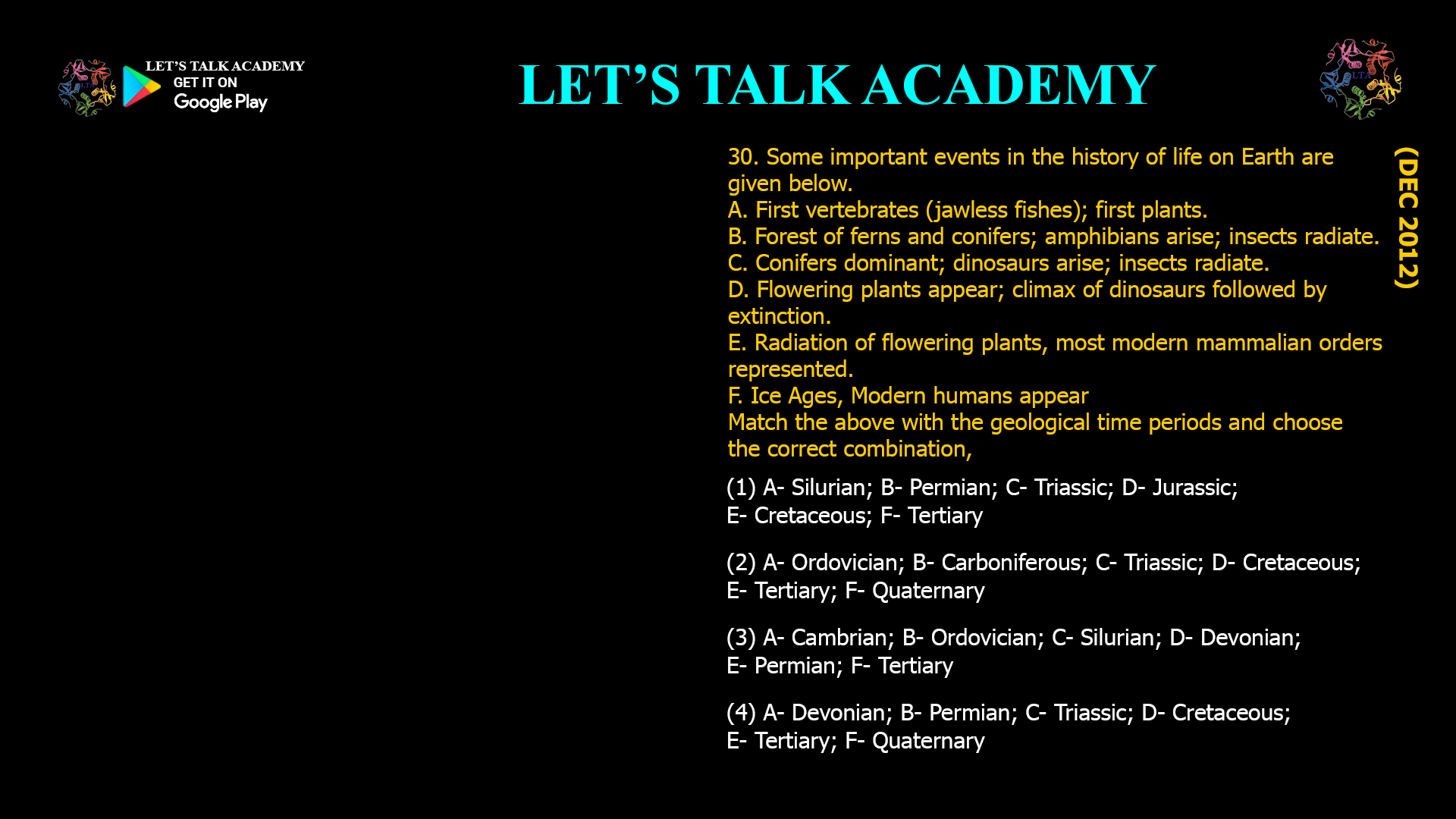- Some important events in the history of life on Earth are given below.
A. First vertebrates (jawless fishes); first plants.
B. Forest of ferns and conifers; amphibians arise; insects radiate.
C. Conifers dominant; dinosaurs arise; insects radiate.
D. Flowering plants appear; climax of dinosaurs followed by extinction.
E. Radiation of flowering plants, most modern mammalian orders represented.
F. Ice Ages, Modern humans appear
Match the above with the geological time periods and choose the correct combination,
(1) A- Silurian; B- Permian; C- Triassic; D- Jurassic; E- Cretaceous; F- Tertiary
(2) A- Ordovician; B- Carboniferous; C- Triassic; D- Cretaceous; E- Tertiary; F- Quaternary
(3) A- Cambrian; B- Ordovician; C- Silurian; D- Devonian; E- Permian; F- Tertiary
(4) A- Devonian; B- Permian; C- Triassic; D- Cretaceous; E- Tertiary; F- QuaternaryMapping Life’s Greatest Events: Matching Major Evolutionary Milestones to the Correct Geological Periods
The history of life on Earth is a fascinating journey marked by dramatic evolutionary leaps, mass extinctions, and the rise and fall of entire groups of organisms. To truly appreciate this story, it’s essential to understand when these milestones occurred and how they align with the geological periods that shape our understanding of deep time. In this guide, we’ll match some of the most important events in the evolution of life to their correct geological periods, providing a clear and accurate timeline for students, educators, and enthusiasts.
Understanding the Geological Time Scale
The geological time scale divides Earth’s 4.5-billion-year history into hierarchical units: eons, eras, periods, and epochs. These divisions are based on major changes in the fossil record, such as the appearance or extinction of significant groups of organisms. The Phanerozoic Eon, which began about 541 million years ago, is especially important because it encompasses the explosion of complex life and all the major evolutionary milestones discussed here.
Key Evolutionary Events and Their Geological Periods
Let’s examine each event in detail and match it to the appropriate geological period:
A. First Vertebrates (Jawless Fishes); First Plants
-
Correct Period: Ordovician
-
Details: The Ordovician Period (about 485–444 million years ago) saw the emergence of the first true vertebrates—jawless fishes known as ostracoderms—and the first land plants, which began to colonize terrestrial environments.
B. Forests of Ferns and Conifers; Amphibians Arise; Insects Radiate
-
Correct Period: Carboniferous
-
Details: The Carboniferous Period (about 359–299 million years ago) is famous for its vast swampy forests dominated by ferns, horsetails, and early conifers. This period also witnessed the rise of amphibians and a major radiation of insects, including the appearance of some of the largest insects in Earth’s history.
C. Conifers Dominant; Dinosaurs Arise; Insects Radiate
-
Correct Period: Triassic
-
Details: The Triassic Period (about 252–201 million years ago) marked the dominance of coniferous trees, the first appearance of dinosaurs, and continued diversification of insects. This period set the stage for the Age of Dinosaurs.
D. Flowering Plants Appear; Climax of Dinosaurs Followed by Extinction
-
Correct Period: Cretaceous
-
Details: The Cretaceous Period (about 145–66 million years ago) saw the emergence and rapid spread of flowering plants (angiosperms). It was also the time when dinosaurs reached their peak diversity, only to be wiped out by a mass extinction event at the period’s end.
E. Radiation of Flowering Plants, Most Modern Mammalian Orders Represented
-
Correct Period: Tertiary
-
Details: The Tertiary Period (now divided into Paleogene and Neogene, spanning 66–2.6 million years ago) was characterized by the explosive radiation of flowering plants and the establishment of most modern mammalian orders.
F. Ice Ages, Modern Humans Appear
-
Correct Period: Quaternary
-
Details: The Quaternary Period (2.6 million years ago to present) is famous for its repeated Ice Ages and the rise of modern humans, Homo sapiens, who became the dominant species on the planet1.
The Correct Matching Combination
Based on the details above, the correct combination is:
(2) A- Ordovician; B- Carboniferous; C- Triassic; D- Cretaceous; E- Tertiary; F- Quaternary
Let’s summarize these matches in a table for clarity:
Event Letter Evolutionary Milestone Geological Period A First vertebrates (jawless fishes); first plants Ordovician B Forests of ferns and conifers; amphibians arise; insects radiate Carboniferous C Conifers dominant; dinosaurs arise; insects radiate Triassic D Flowering plants appear; climax of dinosaurs followed by extinction Cretaceous E Radiation of flowering plants, most modern mammalian orders represented Tertiary F Ice Ages, modern humans appear Quaternary Why These Matches Are Correct
-
Ordovician: This period is recognized for the first vertebrates and the initial colonization of land by plants.
-
Carboniferous: Known for lush forests, giant insects, and the rise of amphibians.
-
Triassic: Marked by the dominance of conifers, the origin of dinosaurs, and insect diversification.
-
Cretaceous: Features the rise of flowering plants and the dramatic end of the dinosaurs.
-
Tertiary: A time of mammalian and flowering plant radiation, setting the stage for modern ecosystems.
-
Quaternary: Defined by Ice Ages and the appearance of modern humans, continuing to the present day1.
The Importance of Geological Context
Understanding when these events occurred helps us appreciate the sequence and pace of evolutionary change. It also highlights the interconnectedness of life and the impact of environmental changes—such as mass extinctions and climate shifts—on the course of evolution.
Conclusion: Building an Accurate Timeline of Life
Matching major evolutionary events to their correct geological periods is essential for anyone interested in Earth’s history. It allows us to see the grand narrative of life’s development, from the first jawless fishes in ancient seas to the emergence of modern humans during the Ice Ages. By placing these milestones in their proper context, we gain a deeper appreciation for the complexity and resilience of life on our planet.
-



